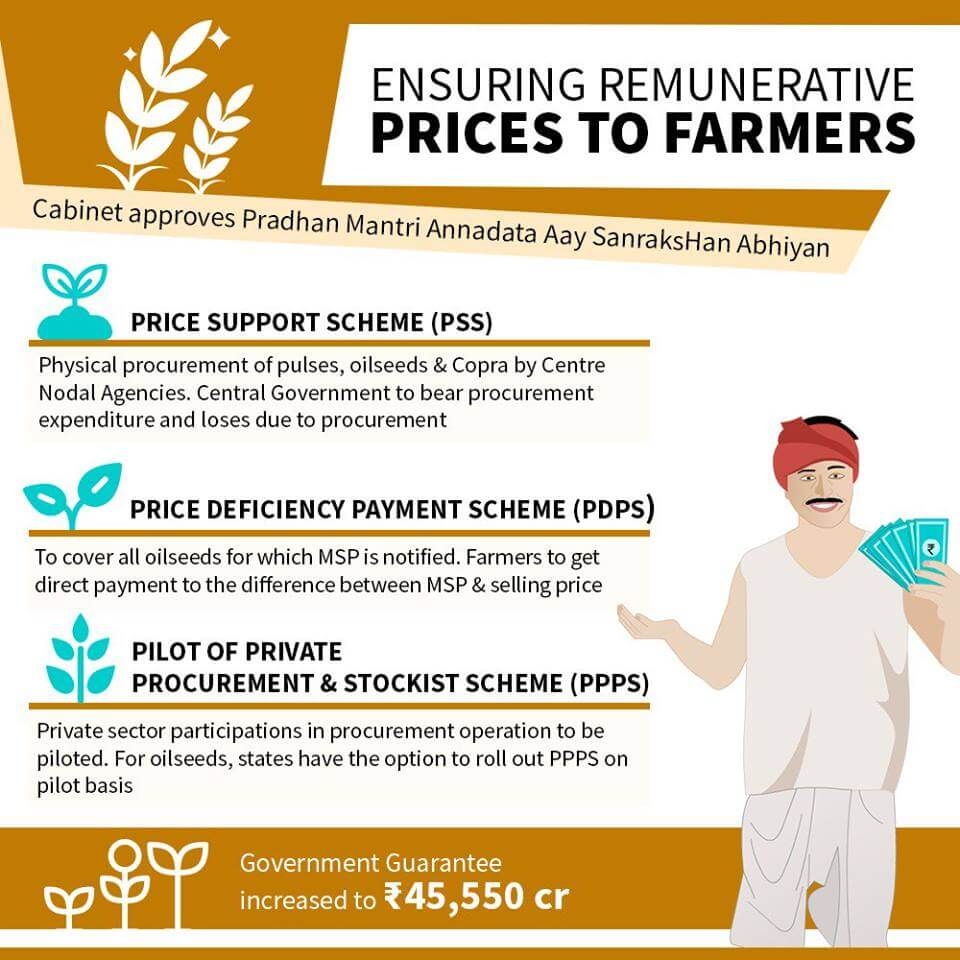Pradhan Mantri Annadata Aay Sanrakshan Abhiyan (PM AASHA)
The Government of India has taken another giant step towards boosting the initiatives of pro-farmers. With the approval of this scheme, the development of the country would be supported. This scheme aims to ensure remunerative prices to the farmers for their produce; the Government of India has taken this step.
This scheme significantly boosts the pro-farmers’ initiatives and keeps the Government’s dedication to Annadata. This will also help protect the farmers’ income, which is expected to go a long way towards the welfare of the farmers. The Government of India has already increased the MSP of the Kharif crops by following the principle of 1.5 times the cost of production. It is also expected that the increase in MSP would be translated to farmers’ income by way of a robust procurement mechanism.
The scheme focuses on ensuring a fair price for the farmers and their products and it will also help to improve the income of the farmers.

Components of Pradhan Mantri Annadata Aay Sanrakshan Abhiyan (PM AASHA)
The components of this Pradhan Mantri Annadata Aay Sanrakshan Abhiyan (PM AASHA) scheme are mentioned below:
- Price Support Scheme (PSS)- Through the Price Support scheme, the procurement of oilseeds and pulses will be carried out by the Central Nodal Agencies with support from the State Governments. The Food Corporation of India will also set up the PSS with NAFED and any expenses incurred will be paid by the Central Government.
- Price Deficiency Payment Scheme (PDPS)- Through the Price Deficiency Payment scheme, all the oilseeds notified for SP will be covered. Also, the difference between the Minimum Support Price (MSP) and the selling price will be made to the registered farmers. All the payments will be made to the bank accounts of the farmers who have been registered. In simple words, no procurement will take place, but rather the difference of payments will be paid to the farmers.
- Pilot of Private Procurement and Stockist Scheme (PPPS)- According to this scheme, the private sector will be taking part in procurement operations. The states will also have an option to carry out this scheme on a pilot basis in the selected APMCs with the involvement of the private sectors.
Challenges for the Pradhan Mantri Annadata Aay Sanrakshan Abhiyan (PM AASHA)
As per the government schemes, the Pradhan Mantri Annadata Aay SanraksHan Abhiyan (PM AASHA) scheme has its share of challenges too and they are mentioned as under:
- It does not strengthen the mechanism of procurement in the country which is robust for rice and wheat.
- As per the 2017 study, only 24% of the households were aware of the MSP in place and they were functioning only in a few states.
- Except for rice and wheat, the quantity of produce procured by the designed state agencies was also limited, which resulted in low awareness.
- As per the evaluation by NITI Aayog, the facilities of procurement in several states were found to be insufficient in the long run.
Initiatives of the Government For Pradhan Mantri Annadata Aay Sanrakshan Abhiyan (PM AASHA)
The Indian Government is committed to releasing the vision of doubling the incomes of farmers by the year 2022. The emphasis was laid on enhancing productivity, reducing the cultivation cost and also strengthening the post-harvesting management, including the market structure. There are several market reforms that have been initiated, including the Livestock Marketing Act, 2017, Model Agricultural Produce and Model Contract Farming and Services Act, 2018. Most of the states in India have taken steps to adopt these initiatives through legislation.
The various efforts are on for a new market architecture in order to ensure that the farmers get remunerative prices on their produce under this scheme Pradhan Mantri Annadata Aay Sanrakshan Abhiyan (PM AASHA). These are as under:
- Setting up of Gramin Agricultural Markets to promote 22000 numbers of the retail market.
- Transparent and competitive wholesale trade ar APMC and a robust and pro-farmer export policy.
- The initiatives of pro-farmers such as the implementation of Pradhan Mantri Krishi Sinchal Yojana, Pradhan Mantri Fasal Bima Yojana, etc. and the distribution of soil health cards have been undertaken.
Conclusion
- The procurement centres must be improved especially with regards to weighing bridges, dying yards, etc.
- More storage and godown facilities must be provided to reduce wastage.
- To save the expenses of transportation, the procurement centres must be located in the villages.
- The NITI Aayog recommends that infrastructure for procurement is crucial for the success of any farmer’s welfare scheme.
Pradhan Mantri Annadata Aay Sanrakshan Abhiyan (PM AASHA) FAQs
✅ When was the scheme launched?
The scheme was launched in September 2018, as an attempt to ensure that the farmers growing oilseeds, pulses, etc. get better prices for their crops.
✅ What is the minimum support price?
The minimum support prices are a guaranteed price for their produce from the Government for Pradhan Mantri Annadata Aay Sanrakshan Abhiyan (PM AASHA).
